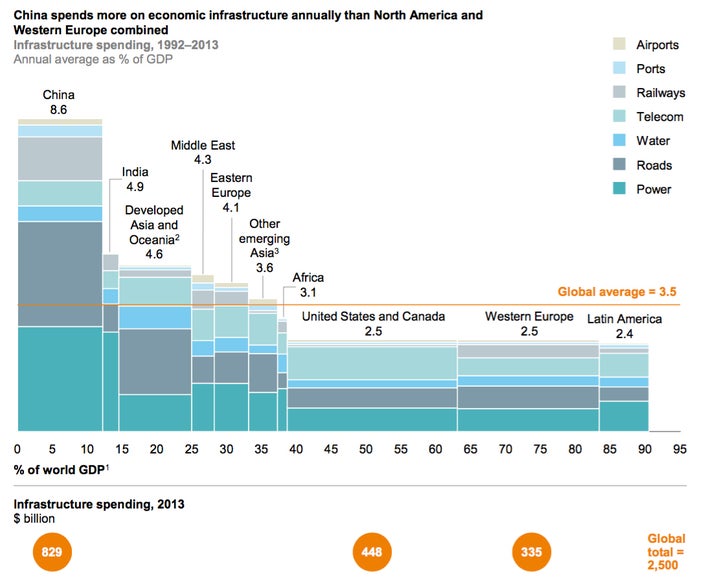During his address to the joint session of Congress on Tuesday, President Trump announced the administration’s intention to push legislation for $1 trillion of investment in the country’s infrastructure. He need not look very far. Vermont Senators Patrick Leahy and Bernie Sanders, together with other leading Senate Democrats, announced in January a $1 trillion plan to finance failing roads, bridges, schools, ports and water and sewerage systems. The “Blueprint to Rebuild America’s Infrastructure” is an ambitious plan to leverage Trump’s promises to address the country’s crumbling infrastructure. Is this a good idea?
I have spent the last two decades working around the world wrestling with the consequences of decisions by politicians and policy makers to defer plans to invest in infrastructure. Sometimes these decisions are prompted by budget constraints but – more often than not – they are caused by complex bureaucracies, concerns around corruption or poor institutional capacity. Even more often, the outlay of significant budgetary resources for long-gestating infrastructure projects falls victim to political time-frames that tend to undervalue the future benefit of this kind of investment. While study after study shows that the overall economic benefits of well-planned and implemented infrastructure are huge, the upfront political costs can be staggering to someone that is trying to get re-elected in a year or two.
In a study published last year, the McKinsey Global Institute (MGI) estimated that the world currently spends $2.5 trillion annually in transport, power, water, and telecom, when $3.3 trillion of annual spending is needed to meet 2030 global growth forecasts. The demand for such investment varies across different countries and reflects both the size and state of development of the economy. It is worth noting that the annual spend (as a percentage of gross domestic product or GDP) varies widely from 8.6% in China to 2.4% in the Latin American countries. The chart below is taken from the MGI study and shows the dramatic differences in spending across regions. Most notable is the fact that the U.S. is spending less than a third of what is invested in China and less than half that of many countries across the rest of Asia.

I do not argue that the U.S. should suddenly double its budget on infrastructure – the difference in spending across countries is natural as the “stock” of infrastructure varies widely. Across developing Asia there are only 6 miles of road for every 1,000 people and reliable electricity is available to only 72% of the population, versus 125 miles of road and 99.8% reliable electricity in the world’s most developed countries. Even so, the American Society of Civil Engineers gave U.S. infrastructure a D+ in its last report card and estimated that $3.6 trillion of investment is needed by 2020. The report card gave Vermont infrastructure a slightly higher grade of C, indicating that continued attention to rebuilding is needed. The report also noted that the 2011 Tropical Storm Irene was a “wake up call” highlighting the need for more resilient infrastructure across the state.
The costs of failing to invest are huge. In 2011, the New America Foundation estimated that poor infrastructure costs the economy in excess of $195 billion per year. With 30% of Vermont’s bridges classified by the American Road & Transportation Builders Association as structurally deficient or functionally obsolete, it is clear that there is a pressing need. You need not go much further than communities on either side of the Champlain Bridge to hear first-hand about the significant costs of its unexpected closure in 2009. Whether it is in longer drive times, poor water quality, long waits at the airport or slow internet connections, the costs of poor infrastructure are real and must be addressed.
I may have convinced you that infrastructure investment is important but you’re probably wondering how we fund it. To start, a significant down payment can be found in the Department of Energy’s loan guarantee program – $41 billion in spending authority already authorized and appropriated for energy infrastructure investment. Much can also be achieved through efficiency gains in the identification and implementation of projects, together with improvements in the management of existing assets. Likewise, the rationalization of some of the more byzantine features of our tax code as well as the introduction of appropriate user fees can help defray costs. The “Blueprint” also makes reference to the creation of an “I-Bank” that would “unlock pools of capital to provide low-cost loans or loan guarantees for appropriate projects across a broad range of sectors”. The MGI study acknowledges that private finance can help support infrastructure investment but unleashing this requires regulatory certainty and the ability to charge prices that produce an acceptable risk-adjusted return. Leveraging private finance from institutional investors will be important but the bulk of this investment will have to come from public and corporate sources. There just isn’t a pure private investment or pure public investment answer to our infrastructure challenge. Anyone that says otherwise just doesn’t understand the problem.
There is no doubt that we need to ramp up our investment in infrastructure and the “Blueprint” is an excellent starting point. Macroeconomic managers will have to work hard to balance the effects of a “fiscal stimulus” against its impact on the strength of the dollar and possible increases in inflation. Likewise, we must also be open to discussion on the tax code and regulatory burdens, all the while being careful to preserve the gains in environmental protection we’ve achieved over the last 50 years. As long as there are no sacred cows in the policy debate and a careful macroeconomic balance is struck, significant infrastructure investment will help unleash economic growth and will also result in millions of new, well-paying jobs. Both of these are critical at a time when millions of people across the county feel like they’re being left behind. In that sense, the “Blueprint to Rebuild America’s Infrastructure” can also go some distance in healing these divisions.
An old Chinese proverb suggests “the best time to plant a tree was 20 years ago. The second best time is now.” Infrastructure investment is something we need now. Let’s get going.
Stephen Groff grew up in Vermont and has spent the last 30 years working on sustainable development issues around the world. He is vice president of the Asian Development Bank (ADB) in Manila, Philippines. The views expressed in this commentary are his and do not necessarily reflect ADB policy.
Please join him on Facebook and follow him on Twitter (@spgroff).
